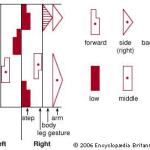Typically whenever I have lessons with other teachers, I ask for the naming convention of steps. I can´t help – I am a German scientist and I believe that it is very important to talk the same precise and descriptive language. The language of Tango, of course, is leading and following, good balance and projection and caring for our precious partners. Without this language, there is no real tango. Tango is all about communication and finding a nonverbal way of communication and connection. This is what we love and this is, what we constantly strive for. Typically half of my private lessons and half of my own training, I use to perfect my abilities and to overcome my depression when I only make slow progress.
During practicing and teaching, it is important to talk about Tango and now, the problems arise. There seems to be not very much common language in tango talk. Especially asking Argentinean teachers about naming conventions is frustrating, because they typically either do not know or refer to the traditional Argentinean teaching method of just copying teacher´s examples.
So what are the basics in this business? First of all, there is the basic step (“el basico”), which nobody seems to love – but everybody uses it for teaching (of foreign tourists). The numbers of the 8-count basic steps are unique and frequently used for normal teaching. “Dance 1-5, turn lady into ocho adelante and…..” is a frequently used instruction utilizing the step number of the basico. Naming parts of the basic step (like I have learned: 1-2 introducion, 3-5 salida, 6-8 resolucion) is again not very common and the term salida can be used in a whole lot of logical contexts.
Even this uniqueness can be compromised by many teachers who start with the second step. I must admit, there are good reasons for doing this and I typically start with the aperture as well, but starting with step number 2 is not really comfortable to teach……
Naturally, we learn techniques in classes and learn how to utilize them for social dancing. The most common thing for Tango websites is to have a list of Tango techniques. Just have a look at the list of this blog or two other very complete lists from other sites (which I consider highly competent):
http://tango.5toll.com/tango-terminology/
http://www.tejastango.com/terminology.html
http://www.verytangostore.com/tango-terms.html
Typically, these lists describe the terminology we need to talk about technical elements and basic Spanish words used in Tango and classes held in Spanish. Generally they are quite good, but the definitions of single terms may be unsharp. They are helpful for everyday tango, but have only limited help, when it comes to writing down choreography.
It is important to talk about choreography, because sometimes you will have to write down steps. I know we live in the century of the video camera, but what if the teacher of the next workshop does not allow videotaping (this happens for example at a very popular tango school in Buenos Aires)? Or if you want to write a choreography which needs to fit exactly to a given piece of music (this is the typical situation when you prepare for show dancing – “Away Satan !” ,“Escenario is evil !” 🙂 ).
Choreography for Tango is typically very personal and usually not for the public (I haven´t seen a good example of written choreography on the internet). Choreography will typically be not perfect, because it does not deal with real body movements. The professional systems for doing so, are difficult to master and not really practical. A good example is Laban-Notation (correct: Labanotation) [1], which is typically used for modern dance. So for couple dances, steps are directly choreographed together with additional information regarding amount and direction of turn, dancehold and rhythm.
Choreography is always difficult. It is a bit easier for highly standardized dances like international ballroom dances, where steps and amount of turn are very well standardized. It gets more difficult for latin dances and can be a real challenge for dances with a low level of standardization like Salsa. For tango it is a real problem, because there are not many sharp definitions we can use. This makes it difficult to write down choreographies for yourself and even more difficult, if you have to write down a choreography for somebody else. I have no real idea how to resolve that problem (without using a video camera). Just to explain the challenge, here a piece of choreography written by me:
1-2 Basico SS 3 Basico, LF forw. Sacada SS Back/Side/Ocho for Lady QQS Close (forw. enrosque) / Bw Sacada QQ Lady side step S Calesita turning left with small bw. steps QQQQ Lady off axis (no step) RF to side S| Lady recover LF fw. S Lady LF bw. (cross system !) RF Sacada to side/back into open step of Lady S Lady RF bw. Stay on RF S Voleo (Lady) with LF S+ LF close, RF to Salida Americana (PP) +S Lady LF forw. into Sal.Americ. wait and uncross (receive Gancho w. left leg) SSS Giro left to Gancho Change weight to RF, LF close +S| Lady RF forw Ocho S+
OK, you may now understand the challenge.
Have fun,
-Richard
[1] http://en.wikipedia.org/wiki/Labanotation

